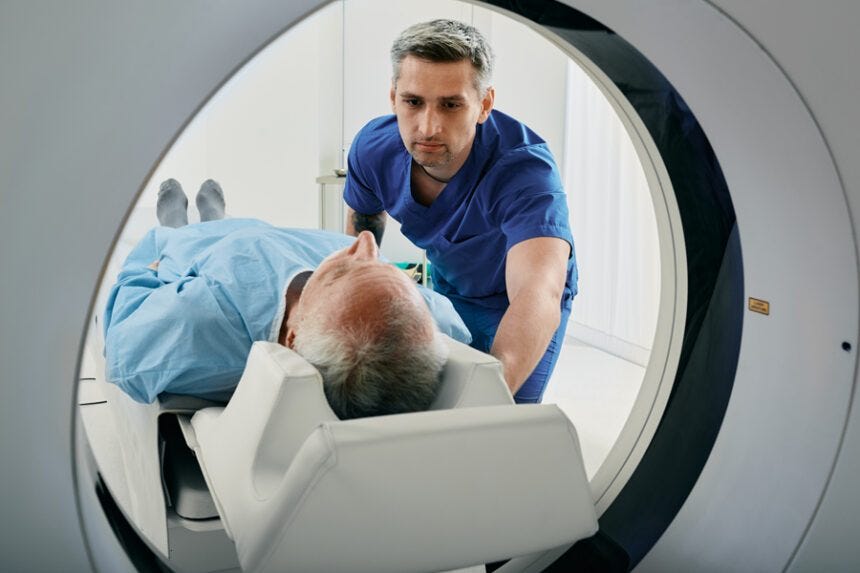Part I: MRI and Claustrophobia: What You Need to Know
MRIs are an increasingly important part of AS--let's conquer claustrophobia and learn to love the scanner
(Editor’s note: Do your fear MRIs? Do you get panic attacks? Do you sweat, and shake? Does your heart pound so loud you hear it? Do you gasp for breath?
(About 15% of us experience these symptoms of claustrophobia, fear of closed spaces, while in the maw of the scanner. Some of us experience this so intensely we have to stop the procedure and leave because the narrow tube closes in on us and we can’t take anymore.
(I am one. I felt like stopping the MRI. I felt trapped and wanted to run.
(I have white-knuckled my way through MRIs for AS. Also, once for a shoulder issue, I felt encased in an MRI machine because my eyes were covered. I was mildly sedated and a kind tech talked me through the procedure.
(I also encountered a cruel tech who threatened and tortured me. I have written about her before. She must have been a burnout. Supposedly, after my complaints, all the way to the president of the University of Chicago Medical Center, Torquemada the Tech was retrained.
(We need to confront this claustrophobia issue. MRIs are increasingly an essential part of the Active Surveillance routine for low-risk prostate cancer to help avoid unnecessary biopsies and to target lesions in fusion biopsies Men treated for advanced prostate cancers also need to undergo post-treatment scanning.
(In Part I, columnist and top radiologist, Antonio Westphalen, of the University of Washington, shares a professional perspective on the problem. In Part II, I will share how I conquered my fear, stopped worrying, and learned to love the MRI.
Please respond to this brief, confidential survey on your experience with MRIs: https://docs.google.com/forms/d/e/1FAIpQLSd8EAd6CkjLdDr2UrUrlZRweHr-M3J4PCJzvbUK-th2bDavZw/viewform?usp=header
(If you have questions about low-risk prostate cancer, your pathology report, your abdominal MRI scan, and diet/lifestyle, please send them to me at howard.wolinsky@gmail.com I will ask The Active Surveillor team of columnists to answer your questions.—HW.)
(Panic attack in an MRI tube. Gemini AI.)
MRI and Claustrophobia: What You Need to Know
For some patients, having an MRI can feel overwhelming. This is not because of the scan itself, but because of the experience of being in a confined space. If you’ve ever felt anxious or panicked in tight spaces, you’re not alone. Claustrophobia, or the fear of enclosed spaces, affects many people and is one of the most common concerns during MRI procedures.
While an MRI scan is a safe exam, the MRI scanner design, often narrow and enclosed, can be difficult for people who are prone to anxiety or claustrophobia. Most patients complete their scan without any problems, but up to 15% experience significant anxiety. And about 2% need sedation or are unable to finish the scan.
When anxiety interferes with scanning, it can delay diagnosis and treatment. If the scan has to be scheduled with sedation, both cost and complexity increase. Patients may need to fast, arrange transportation, and take time off work or other responsibilities. Repeat scans due to motion during the exam, which lowers image quality, reduce efficiency for both the patient and the imaging department.
Radiology teams are well aware of these challenges and we take them seriously. Radiology technicians, radiologists, and other staff are trained to recognize signs of anxiety and support patients throughout the process. If you’re feeling worried before your scan, there are many strategies available to help.
In some cases, radiology departments can also adjust the imaging protocol to help patients who are struggling with claustrophobia. This might involve shortening the scan duration by using fewer imaging sequences. While this approach can make the experience more tolerable, it does come with trade-offs. For example, instead of a full multiparametric MRI, a biparametric MRI or a more abbreviated protocol might be used. These shorter protocols can still provide valuable diagnostic information, but they may not capture as much detail as a full scan. The decision to modify the protocol is made carefully, balancing the need for diagnostic accuracy with the patient’s ability to complete the exam comfortably.
Clear and supportive communication is crucial, as knowing what to expect can reduce anxiety. The technologist can explain how long the scan will take, what noises you will hear, and how you will stay in touch with them during the exam. You will usually have a buzzer in your hand and can stop the scan at any time. Feel free to ask any questions before and during the exam.
Patients are often allowed to bring a companion into the scan room, which can provide a reassuring presence during the procedure. This simple act of support can significantly reduce anxiety, especially for those who experience claustrophobia. In addition, many imaging centers now offer a variety of comfort tools to help patients feel more at ease.
Listening to music through headphones is a common option, allowing patients to focus on familiar or calming sounds rather than the mechanical noises of the MRI machine. Some facilities even let patients choose their own playlists. Others offer calming videos or guided meditations that can be viewed through special video goggles or screens, helping to distract the mind and reduce stress.
Wearing an eye mask is another effective strategy, especially for those who feel overwhelmed by the confined space. By blocking out visual stimuli, patients can avoid focusing on the narrowness of the scanner and instead concentrate on breathing or relaxation techniques.
Some imaging centers go a step further by providing special prism glasses or angled mirrors that allow patients to see out of the scanner while lying down. This can create the illusion of openness and help reduce the sensation of being enclosed.
Many institutions now use MRI machines that are wider and shorter, which feel less enclosed. Open MRI scanners are also available in some locations, though scan times may be longer and image quality may vary or not be ideal depending on the type of exam.
Some patients benefit from videos or even virtual reality programs that walk them through what an MRI is like before the day of their scan. Previewing or practicing the environment ahead of time can make it more familiar and less intimidating.
For patients with more severe anxiety, anti-anxiety medication may be an option. These medications are generally safe when used as directed, but they do come with a few requirements. You may need to fast beforehand, arrange for someone to take you home, and avoid driving for the rest of the day. In most cases, you will need to get a prescription from your referring doctor before the scan, so be sure to discuss this with them early on if you are concerned about claustrophobia.
Deep breathing and other calming techniques can also help. Some patients find it helpful to mentally focus on why they are having the scan, how the results will support their care and give their doctors important answers. Others “transport” to their ideal vacation spot.
Claustrophobia is a common and understandable response, and imaging staff are always ready to help. Do not hesitate to talk to your care team ahead of time if you are feeling nervous. The more they know, the more they can do to support you, before, during, and after your scan.
With the right preparation and support, most patients are able to complete their MRI successfully, even those who were very anxious at first.
Your comfort and care matter to us.
Dr. Westphalen is the Section Chief of abdominal imaging at the University of Washington and UW professor of radiology. Dr. Westphalen’s research interests are centered on the use of advanced imaging technologies to diagnose and treat patients with prostate cancer.
Please respond to a confidential survey on your MRI experience.
July webinar: 'Why All Men Diagnosed with Prostate Cancer Should Undergo Germline Genetic Testing'
ASPI (Active Surveillance Patients International) has assembled a panel of genetics experts to address genetic and prostate cancer.
The session will run from noon to 1:30 pm Eastern time on Saturday, July 26.
Please register for the meeting here.
There will be a Question-and-Answer session following remarks by the panel. Please send questions in advance to: contactus@aspatients.org
Please respond to my confidential survey on genetic testing and PCa. Click here: https://forms.gle/Uv9d5gaZYHadZ5Qh9
Also:
Please answer this questionnaire on transperineal vs. transrectal biopsies: https://forms.gle/GShpHwegEPtAVgTs9 I have a relevant story coming, and you can take a few minutes and help if you haven’t already.






I have some eyeshades that contain no metal. I just put them over my eyes and I'm good until the procedure is finished.
My last MRI involved the prostate and I was only put in the tube half way. With my head not in the tube, claustrophobia was a non-issue for me.
From Peter Christy,
Howard:
Something else we have in common … claustrophobia!
Not only MRI and CT ’tunnels” but also the “upper berth” on the AutoTrain to Florida. Our first time was difficult and I had to climb down the ladder so that my wife could “talk me out of” staying up all night … it is important to be well rested when we arrived at Sanford as it took half of the arrival day before we got to our condo on Sanibel.
Ir wasn’t the size, the length or the comfort of the upper berth, but more that the ceiling was “too low” … when I opened my eyes it was right in front of me! It was obvious how I had to deal with it … close my eyes, don’t think about it and let the motions and the rhythmic sounds of the AutoTrain lull me to sleep.
Peter